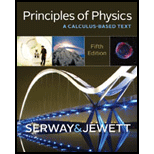
Concept explainers
(a)
The location of the particle and the charges on them.
(a)
Answer to Problem 18P
The location on first particle is
The location on second particle is
Explanation of Solution
Write the expression of standard equation for the potential difference.
Here,
Write the expression of standard equation for the electric filed.
Here,
Write the expression for the given potential difference.
Here,
Write the expression for the given electric field.
Here,
Conclusion:
Comparing equation (II) and (IV), the first particle is having charge with magnitude
The location of the first particle is
Thus, The location on first particle is
Comparing equation (II) and (IV), the second particle is having charge with magnitude
The location of the second particle is
Thus, the location on second particle is
(b)
The force acting on charge -16.0 nC.
(b)
Answer to Problem 18P
The force acting on charge -16.0 nC is
Explanation of Solution
Rewrite the expression for the given electric field from equation (IV).
Write the expression for the force action on the charge.
Here,
Conclusion:
Substitute
Thus, the force acting on charge -16.0 nC is
(c)
The work done required to move the charge.
(c)
Answer to Problem 18P
The work done required to move the charge is
Explanation of Solution
Rewrite the expression for the given potential difference by using equation (III).
Write the expression for the required work done.
Here,
Conclusion:
Substitute
Thus, the work done required to move the charge is
Want to see more full solutions like this?
Chapter 20 Solutions
Principles of Physics: A Calculus-Based Text
 Principles of Physics: A Calculus-Based TextPhysicsISBN:9781133104261Author:Raymond A. Serway, John W. JewettPublisher:Cengage Learning
Principles of Physics: A Calculus-Based TextPhysicsISBN:9781133104261Author:Raymond A. Serway, John W. JewettPublisher:Cengage Learning Physics for Scientists and Engineers, Technology ...PhysicsISBN:9781305116399Author:Raymond A. Serway, John W. JewettPublisher:Cengage Learning
Physics for Scientists and Engineers, Technology ...PhysicsISBN:9781305116399Author:Raymond A. Serway, John W. JewettPublisher:Cengage Learning Physics for Scientists and Engineers: Foundations...PhysicsISBN:9781133939146Author:Katz, Debora M.Publisher:Cengage Learning
Physics for Scientists and Engineers: Foundations...PhysicsISBN:9781133939146Author:Katz, Debora M.Publisher:Cengage Learning Physics for Scientists and Engineers with Modern ...PhysicsISBN:9781337553292Author:Raymond A. Serway, John W. JewettPublisher:Cengage Learning
Physics for Scientists and Engineers with Modern ...PhysicsISBN:9781337553292Author:Raymond A. Serway, John W. JewettPublisher:Cengage Learning Physics for Scientists and EngineersPhysicsISBN:9781337553278Author:Raymond A. Serway, John W. JewettPublisher:Cengage Learning
Physics for Scientists and EngineersPhysicsISBN:9781337553278Author:Raymond A. Serway, John W. JewettPublisher:Cengage Learning College PhysicsPhysicsISBN:9781938168000Author:Paul Peter Urone, Roger HinrichsPublisher:OpenStax College
College PhysicsPhysicsISBN:9781938168000Author:Paul Peter Urone, Roger HinrichsPublisher:OpenStax College





